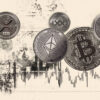Ripple (XRP) Continues Upward Trend Amid Positive Market Sentiment
Ripple (XRP) is experiencing its second consecutive day of gains, fueled by positive market sentiment and consistent institutional demand. The price of XRP is currently hovering around $2.28. If risk appetite remains high, the cross-border money transfer token could surpass $2.33, a level that previously capped price action in mid-May.
XRP Shows Bullish Signals with Steady Capital Inflows
Digital asset products saw over $1.03 billion in weekly inflows, according to a CoinShares report. XRP-related financial products received $10.6 million in inflows, bringing the year-to-date total to $335 million. Total assets under management (AUM) average around $1.4 billion.
The United States accounted for the majority of weekly capital inflows, with $1 billion, of which $790 million went to Bitcoin ETFs, BTC treasuries, and other related financial products.
“Price gains during the week brought total assets under management to a new all-time high of $188 billion. Trading volumes reached $16.3 billion, in line with the weekly average so far this year,” the CoinShares report stated.
Interest in XRP spans various market sectors, including open interest in futures contracts (OI), which has increased by approximately 25% to $4.69 billion since falling to $3.54 billion on June 23. This is the highest level since May 30.
A significant increase in futures contract trading volume to $4.72 billion indicates growing market activity. This, combined with the increase in open interest, suggests that traders have a bullish bias and are willing to bet on future price increases.
Liquidations totaling $2.52 billion have been recorded in the last 24 hours, with short positions accounting for $1.52 million compared to approximately $997,000 eliminated in shorts.
Technical Outlook: XRP Exhibits Bullish Structure
XRP bulls are printing the second consecutive green candle on the daily chart, supported by consistent interest in the token. Key technical indicators support the recovery and point to a breakout above the tested resistance at $2.33 in mid-June and $2.47 on May 23.
A buy signal from the Moving Average Convergence/Divergence (MACD) indicator encourages traders to seek exposure. This signal occurs when the blue MACD line crosses above the red signal line. Green histogram bars above the zero line reinforce the bullish momentum.
At the same time, a rising Relative Strength Index (RSI) at 57 shows that the uptrend has strength and could continue this week.
In the event of a breakout above the short-term supply zone at $2.33, the bullish reach could expand beyond the obstacle at $2.47 to the XRP peak in May, around $2.65.
However, a trend reversal cannot be ruled out, especially given that market sentiment remains unstable due to U.S. tariffs. The 90-day pause on tariffs ends on July 9, suggesting uncertainty in global markets.
With this in mind, traders should prepare for the possibility of a pullback towards the lower support in June at $1.90. However, the 100-day exponential moving average (EMA) currently at $2.22, the 50-day EMA at $2.21, and the 200-day EMA at $2.11 could absorb potential selling pressure, thus preventing a price drop below the $2.00 level.
Ripple – Frequently Asked Questions
Is XRP a Security?
It depends on the transaction, according to a court ruling published on July 14: For institutional investors or over-the-counter sales, XRP is a security. For retail investors who purchased the token through programmatic sales on exchanges, on-demand liquidity services, and other platforms, XRP is not a security.
What is the SEC Lawsuit Against Ripple?
The U.S. Securities and Exchange Commission (SEC) accused Ripple and its executives of raising over $1.3 billion through an unregistered asset offering of the XRP token. Although the judge ruled that programmatic sales are not considered securities, sales of XRP tokens to institutional investors are investment contracts. In the latter case, Ripple did violate U.S. securities law and will have to continue litigating for the approximately $729 million it received under written contracts.
What Does the Ruling Mean for Ripple and the Crypto Industry?
The ruling offers a partial victory for both Ripple and the SEC, depending on what you look at. Ripple obtains a major victory over the fact that programmatic sales are not considered securities, and this could bode well for the cryptocurrency sector in general, as most of the assets in the SEC’s sights are handled by decentralized entities that sold their tokens mainly to retail investors through exchange platforms, experts say. Even so, the ruling does not help much to answer the key question of what makes a digital asset a security, so it is still unclear whether this lawsuit will set a precedent for other open cases affecting dozens of digital assets. Issues such as what is the appropriate degree of decentralization to avoid the “security” label or where to draw the dividing line between institutional and programmatic sales are likely to persist.
How Does This Affect the SEC’s Regulatory Approach?
The SEC has intensified its enforcement actions towards the blockchain and digital asset industry, filing charges against platforms such as Coinbase or Binance for alleged violation of U.S. Securities Law. The SEC claims that most crypto assets are Securities and are therefore subject to strict regulation. While defendants may use parts of the Ripple ruling in their favor, the SEC may also find in it reasons to maintain its current strategy of regulation through enforcement.
What’s Next for the Ripple vs. SEC Case?
The court ruling is a partial summary judgment. The ruling can be appealed once a final judgment is issued or if the judge allows it before. The case is in a pre-trial phase, in which both Ripple and the SEC still have the possibility of reaching an agreement.
Stay ahead of the curve in the fast-paced crypto world – explore the latest updates and trends at Cryptonewsfeeds.com.










